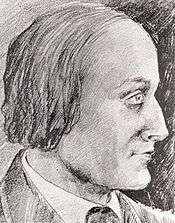Cleng Peerson
Cleng Peerson (17 May 1783 – 16 December 1865) was a Norwegian-American pioneer who led the first group of Norwegians to emigrate to the United States, traveling on the Norwegian sloop Restauration. [1] [2]

Background
Cleng Peerson was born Klein Pedersen near the community of Tysvær in the county of Rogaland, Norway. His parents were Peder Larsson (1755–1841) and Inger Sjursdotter (1744–1814). Cleng Peerson grew up on the farm Hesthammar in Tysvær, but was born on the farm Lervik in the same district. In 1821, he first traveled to the United States at the request of a religious community in Stavanger. This community was made up principally of Quakers, together with Haugeans, both groups having been influenced by the beliefs of German Rappites.[3]
Immigration
In 1824, when Peerson came back to Norway, it was decided that a group should emigrate. Peerson returned to America to prepare for their arrival. Cleng Peerson met the immigrants when they landed in New York on October 9, 1825. They moved to northern New York, settling about 35 miles (56 km) northwest of Rochester in the town of Kendall, near Lake Ontario, in Orleans County. The road that ran through this settlement is today known as Norway Road.[4][5]
In 1834, Cleng Peerson led a group of settlers to a little settlement on the Illinois River, in the Fox River Valley. The community of Norway in LaSalle County, Illinois is the site of the Norwegian Settlers Memorial which was dedicated in 1934.[6]
Starting in 1838, Peerson returned to Norway several times. By 1840, Peerson had settled in Sugar Creek in Montrose Township, Lee County in the southeastern part of Iowa. Cleng Peerson was listed in the United States census records as a settler in 1840. He lived here for several years, including the period 1840–47. In 1847, he joined the Swedish immigrant society at Bishop Hill Colony in Henry County, Illinois, which had been founded by sect leader Erik Janson.[7]
During 1854, the Texas State Legislature granted Peerson 320 acres (1.3 km2) of land west of Clifton, in Bosque County, Texas. Peerson lived here until his death in 1865 and was buried in the cemetery by Our Savior's Lutheran Church in Cranfills Gap. [8][9]
Personal life
Peerson married the Swedish-born widow Ane Cathrine Saelinger (1749–1831) in 1807. He later married Maria Charlotta Dahlgren (1809 – ca. 1849) who had emigrated from Sweden in 1846.
Legacy
- In 1947 and 1975, Cleng Peerson was featured on Norwegian postage stamps.[10]
- During 1982, King Olav V of Norway visited Texas in recognition of the 200th anniversary of the birth of Cleng Peerson.[11]
- Cleng Peerson Research Library and Cleng Peerson Institute are both located in Clifton, Texas.[12]
- Tysvær municipality has announced plans for the Cleng Peerson Center.[13]
Primary Source
The True Saga Of Cleng Peerson by historian Alfred Hauge (translated by John Weinstock and Turid Sverre. foreword by Carl W. W. Sorenson. Special Projects Committee, Norwegian Society of Texas; 1982) provides an authoritative history of the life and times of Cleng Peerson. The three volume series were published in Norwegian between 1961 and 1965 by Gyldendal Norsk Forlag.
References
- Nils Olav Østrem. "Cleng Peerson, Pioner". Norsk biografisk leksikon. Retrieved October 3, 2015.
- Bjorn Sletto (May 1996). "Trailblazer" (PDF). Viking. Archived from the original (PDF) on October 5, 2015. Retrieved October 3, 2015.
- Haugeans, Rappites, and the Emigration of 1825 (by Ingrid Semmingsen, translated by C. A. Clausen. Norwegian-American Historical Association. Volume 29: Page 3)
- The Norwegian Quakers of 1825 (Henry J. Cadbury, Norwegian-American Historical Association. Volume I: Page 60)
- The Kendall Settlement Survived (Richard L. Canuteson, Norwegian-American Historical Association. Volume 27: Page 243)
- Norwegian Settlers Memorial Archived 2009-03-27 at the Wayback Machine (Illinois Historic Preservation Agency)
- The Sugar Creek Settlement in Iowa (H. F. Swansen. Norwegian-American Historical Association. Volume IX: Page 38)
- Recollections of a Norwegian Pioneer in Texas (Knudt Olson Hastvedt, translated and edited by C. A. Clausen. Norwegian- American Historical Association. Volume XII: Page 91)
- Norwegian Collection Archived 2008-09-30 at the Wayback Machine (Bosque Museum. Clifton, Texas)
- Orm Øverland (March 30, 2015). "Cleng Peerson". Store norske leksikon. Retrieved October 2, 2015.
- The Handbook of Texas (Published by the Texas State Historical Association)
- "The Legacy of Cleng Peerson". The Cleng Peerson Institute. October 14, 2014. Archived from the original on October 6, 2015. Retrieved October 2, 2015.
- "Cleng Peerson Center". Cleng Peerson Center. Retrieved October 2, 2015.
Other sources
- De Pellis, Mario S. Cleng Peerson and the Cummunitarian Background of Norwegian Immigration (Norwegian-American Historical Association. Volume 2I: Page 136)
- Lovell, Odd S. (2015) Across the Deep Blue Sea: The Saga of Early Norwegian Immigrants (Minnesota Historical Society Press) ISBN 978-0873519618